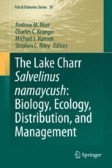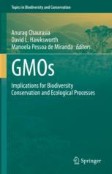Search
Search Results
-
Metabolic response of bluegill to exercise at low water temperature: implications for angling conservation
The metabolic response of fish to exercise is highly dependent on environmental factors such as temperature. In addition to natural challenges that...

-
Trophic Ecology
The trophic ecology of lake charr Salvelinus namaycush morphotypes from small and large lakes within their native and introduced ranges is reviewed...
-
Regime change in a large-floodplain river ecosystem: patterns in body-size and functional biomass indicate a shift in fish communities
Changes in species dominance may drive regime shifts because dominant biotic feedbacks reflect functional traits of a community. Changes in species...

-
Bigmouth Buffalo Ictiobus cyprinellus sets freshwater teleost record as improved age analysis reveals centenarian longevity
Understanding the age structure and population dynamics of harvested species is crucial for sustainability, especially in fisheries. The Bigmouth...

-
The unaddressed threat of invasive animals in U.S. National Parks
Invasive species, both plants and animals, are a long-standing threat to the National Parks of the United States. For nearly two decades the National...

-
Concordance of chemically inferred and assayed nutrient limitation of phytoplankton along a depth gradient of alpine lakes in the Canadian Rockies
Deposition of nutrients over mountainous regions in many parts of the world is increasing due to human activities. To assess the level of agreement...

-
Menhaden, the Inedible Fish that Most Everyone Eats
Atlantic menhaden Brevoortia tyrannus are an abundant member of the family Clupeidae. This fish is essential to the ecology of the Chesapeake Bay and...
-
Genetically Engineered Fish: Potential Impacts on Aquaculture, Biodiversity, and the Environment
Studies on transgenic fish for the aquaculture industry have focused on improving growth rates, enhancing disease resistance, altering body...
-
Pathways of unauthorized fish introductions and types of management responses
Unauthorized introductions are an ongoing problem for fisheries managers. To understand reasons for the continued spread of nonnative fish species,...

-
Long-term trends in seasonal plankton dynamics in Lake Mead (Nevada-Arizona, USA) and implications for climate change
Over the past few decades, Lake Mead (Nevada-Arizona, USA) has experienced multiple ecosystem stressors including drought, increased water demand,...

-
Towards a cohesive strategy for the conservation of the United States’ diverse and highly endemic crayfish fauna
Freshwater biodiversity of the United States has long been recognized for its high level of species richness. The US crayfish fauna is richer than...

-
A perspective on e-flows at hydroelectric projects in Canada
Setting e-flows (instream, environmental or ecological flow regimes) for existing or new hydroelectric and other projects is a key worldwide...
-
Acute exposure of larval rainbow trout (Oncorhynchus mykiss) to elevated temperature limits hsp70b expression and influences future thermotolerance
As poikilotherms, fish health is compromised by exposure to elevated temperatures (e.g. climate change-related warming, anthropogenic thermal...

-
Influences of Lake Trout (Salvelinus namaycush) and Mysis diluviana on kokanee (Oncorhynchus nerka) in Lake Pend Oreille, Idaho
Research on Lake Pend Oreille, Idaho, has focused on the influence of two potential limiting factors for kokanee Oncorhynchus nerka (Walbaum, 1792):...

-
Age, growth, and age at maturity of bonefish (Albula species) among Cuban habitats
Bonefish ( Albula spp.) are a prized sportfish among avid anglers worldwide. Two morphologically indistinguishable species of bonefish ( Albula vulpes ...

-
Behavioral observations of bonefish (Albula vulpes) during prespawning aggregations in the Bahamas: clues to identifying spawning sites that can drive broader conservation efforts
Bonefish are typically thought of as ‘flats fish’ that reside in shallow, tropical and subtropical nearshore coastal waters. However, evidence from...

-
Ontogenetic patterns in resource use dynamics of bonefish (Albula vulpes) in the Bahamas
We used stable isotope analysis to examine ontogenetic patterns in the resource use dynamics of bonefish ( Albula vulpes ) collected from two locations...

-
Linking bonefish (Albula vulpes) populations to nearshore estuarine habitats using an otolith microchemistry approach
Identifying the relative importance of various nursery areas is critical for understanding the ecological roles of diverse juvenile habitats, as well...

-
Management of Landscapes for Established Invasive Species
Long-term management strategies are invoked once an invasive species has become established and spread beyond feasible limits for eradication or...
-
Shifts in the Skin-Associated Microbiota of Hatchery-Reared Common Snook Centropomus undecimalis During Acclimation to the Wild
The skin-associated microbiota of fish competes against pathogens for space and nutrients, preventing colonization by harmful bacteria encountered...

